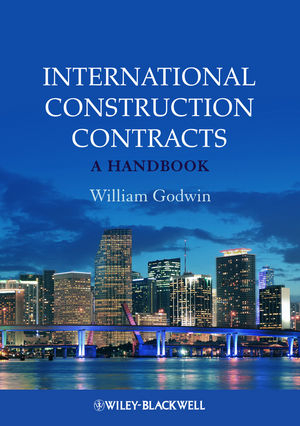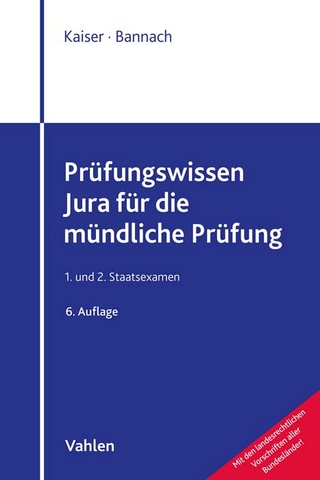
International Construction Contracts
Wiley-Blackwell (Verlag)
978-0-470-65572-6 (ISBN)
- Titel ist leider vergriffen;
keine Neuauflage - Artikel merken
Many large construction projects, such as those in the Middle East or Asia Pacific, are international in scope with a range of contractors and subcontractors signing contracts for delivery of specified work or services. The contractual situation in these instances may be complex and potentially includes a range of standard and bespoke contractual arrangements. In addition, the parties to these contracts may be based in different parts of the world, and are often working to different legal systems and understandings. This can lead to confusion in the understanding, interpretation and execution of a given contract. International Construction Contracts provides concise and practical guidance to those involved in the negotiation and management of international construction and engineering contracts. It sets out in clear, straightforward language the main features of construction contracts and international dispute resolution procedures. It ensures the reader is aware of the issues that might arise on the contractual side of their project so that they may better protect their party's interests.
Many of the features and points discussed are illustrated by reference to the popular FIDIC contracts and the book includes a commentary on the two most widely used FIDIC design-build forms, the Yellow and Silver Books. Also included in the book is a fully worked example of a typical ICC arbitration from start to finish, with "pleadings", a detailed case narrative and commentary on events, and an example arbitration award. The ICC and SIAC arbitration rules are also provided. Written for construction professionals, the book will be of great interest to engineers, architects, project managers, quantity surveyors, contract managers and contract administrators working on international projects.
William Godwin is a barrister specialising in construction, engineering, energy and infrastructure projects and has over twenty years experience of international construction acting for contractors, employers, developers and consultants in projects of all kinds. A regular speaker at the FIDIC international users conferences, William conducts accredited training in the FIDIC contracts through Matrix Seminars, is an arbitration panel member of the China International Economic and Trade Arbitration Commission and the Dubai International Arbitration Centre, and an approved adjudicator of the English Technology and Construction Bar Association.
Preface xiii Foreword by Vivian Ramsey xv Acknowledgements xvii About the Author xix Part I 1 1 Contract 3 1.1 What is a contract? 3 1.2 Agreement 4 1.3 Do contracts need to be in writing? 5 1.4 Other elements of a contract 5 1.5 Capacity and authority 6 1.6 Importance of a written contract 8 1.6.1 Clarity and certainty 8 1.6.2 Procedures 9 1.6.3 Risk allocation 9 1.7 What should a properly written construction contract cover? 10 1.7.1 FIDIC contracts 11 1.7.2 Programme 12 1.7.3 Delays and extensions of time 12 1.7.4 Delay damages 13 1.8 Tailoring the contract 14 2 Risk 15 2.1 How risk may be allocated 15 2.2 The traditional approach to risk 16 2.3 EPC/turnkey projects 18 2.4 BOT-type projects 18 2.4.1 Parties to a BOT-type project 18 2.4.2 Contracts involved in a BOT-type project 20 2.5 The FIDIC Silver Book 22 2.6 Particular risks: The unforeseen and design 24 2.6.1 Unforeseeable physical conditions 24 2.6.2 Design responsibility 24 3 Types of Construction Contract 27 3.1 Lump sum contracts 27 3.2 Prime cost or reimbursable contracts 28 3.3 Unit price contracts 28 3.4 Target contracts 29 3.5 Which contract? 29 Part II 31 4 The FIDIC Design-Build Contracts 33 4.1 Some key general provisions 34 4.1.1 Communications: Clause 1.3 34 4.1.2 The law and the language of the contract: Clause 1.4 35 4.1.3 The priority of documents: Clause 1.5 35 4.1.4 Compliance with laws: Clause 1.13 36 4.2 The Employer 37 4.2.1 The right of access to, and possession of, the site: Clause 2.1 37 4.2.2 Evidence of the Employer s financial arrangements: Clause 2.4 37 4.2.3 Employer s claims against the Contractor: Clause 2.5 38 4.3 Contract administration: Clause 3 39 4.3.1 The role of the Engineer 39 4.3.2 Determinations in the Yellow and Silver Books 40 4.3.3 Employer s Representative in the Silver Book 41 4.3.4 The giving of instructions 41 4.4 The Contractor 41 4.4.1 The Contractor s general obligation: Clause 4.1 41 4.4.2 The works which must fit the intended purpose: Clause 4.1 43 4.4.3 Securing performance: Clause 4.2 43 4.4.4 Contractor s Representative: Clause 4.3 44 4.4.5 Subcontracting: Clauses 4.4 and 4.5 44 4.4.6 Setting out: Clause 4.7 44 4.4.7 Sufficiency of the Contract Price (Silver Book) or Accepted Contract Amount (Yellow Book): Clause 4.11 45 4.4.8 Unforeseeable difficulties/physical conditions: Clause 4.12 45 4.4.9 Progress reports: Clause 4.21 45 4.5 Design 46 4.5.1 The Contractor s general design obligations (Yellow and Silver Books): Clause 5.1 46 4.5.2 Contractor s documents: Clause 5.2 46 4.5.3 Contractor s undertaking: Clause 5.3 47 4.6 Staff and labour: Clause 6 47 4.7 Plant, materials and workmanship 48 4.7.1 Executing the works: Clause 7.1 48 4.7.2 Samples: Clause 7.2 48 4.7.3 Inspections: Clause 7.3 48 4.7.4 Testing: Clause 7.4 49 4.7.5 Rejection and remedial work: Clauses 7.5 and 7.6 49 4.7.6 Ownership: Clause 7.7 50 4.8 Time: commencement, delays and suspension of the works 50 4.8.1 Commencement and time for completion of the works: Clauses 8.1 and 8.2 50 4.8.2 Programme: Clause 8.3 50 4.8.3 Delays and extensions of time: Clause 8.4 52 4.8.4 Suspension of the works: Clauses 8.8 to 8.10 52 4.8.5 Prolonged suspension: Clause 8.11 53 4.9 Tests on completion 53 4.9.1 Contractor s obligations: Clause 9.1 53 4.9.2 Delayed tests: Clause 9.2 54 4.9.3 Re-testing: Clauses 9.3 and 9.4 54 4.10 Employer s taking over 54 4.10.1 Taking over of the works: Clause 10.1 54 4.10.2 Taking over of part of the works: Clause 10.2 55 4.11 Defects liability 56 4.11.1 The Defects Notification Period: Clauses 11.1 to 11.3 56 4.11.2 Failure to remedy defects: Clause 11.4 56 4.11.3 Extending the DNP: Clause 11.3 57 4.11.4 Further tests: Clause 11.6 57 4.11.5 The Performance Certificate: Clause 11.9 57 4.11.6 Unfulfilled obligations: Clause 11.10 58 4.12 Tests after completion 58 4.13 Variations and adjustments to the contract price 58 4.13.1 Right to vary: Clause 13.1 58 4.13.2 Variation procedure and value engineering: Clauses 13.2 and 13.3 59 4.13.3 Changes in legislation: Clause 13.7 59 4.13.4 Cost fluctuations: Clause 13.8 60 4.14 Payment 60 4.14.1 Interim payments: Clause 14.3 60 4.14.2 Timing of interim payments: Clause 14.7 61 4.14.3 Advance payment: Clause 14.2 61 4.14.4 Retention money: Clauses 14.3 and 14.9 61 4.14.5 Delayed payment and the right to financing charges: Clause 14.8 62 4.14.6 Financial steps after Taking Over: Clauses 14.10 to 14.13 63 4.14.7 Cessation of Employer s liability: Clause 14.14 64 4.15 Termination by the Employer 64 4.15.1 Termination for Contractor default: Clause 15.2 65 4.15.2 Valuation for works executed at date of termination: Clause 15.3 66 4.15.3 Payments after termination: Clause 15.4 66 4.15.4 Termination for convenience: Clause 15.5 66 4.16 Suspension and termination by the Contractor 66 4.16.1 Suspension: Clause 16.1 66 4.16.2 Termination: Clause 16.2 67 4.16.3 Events after termination: Clause 16.3 67 4.16.4 Payment on termination: Clause 16.4 67 4.17 Risk and responsibility 68 4.17.1 Indemnities: Clause 17.1 68 4.17.2 Contractor s care of the works: Clause 17.2 69 4.17.3 Specific Employer s risks: Clauses 17.3 and 17.4 69 4.17.4 Limitation of liability: Clause 17.6 70 4.18 Insurance 71 4.19 Force majeure 71 4.19.1 Meaning of force majeure : Clause 19.1 71 4.19.2 Notice: Clause 19.2 72 4.19.3 Minimising delay and the consequences of force majeure: Clauses 19.3 and 19.4 72 4.19.4 Prolonged force majeure: Clause 19.6 73 4.19.5 Release from performance under the law: Clause 19.7 73 4.20 Contractor s claims, disputes and arbitration 74 4.20.1 Contractor s claims: Clause 20.1 74 Part III 77 5 Disputes and How to Resolve Them 79 5.1 Introduction 79 5.2 Legal aspects of a construction project 79 5.2.1 The terms of the construction contract 80 5.2.2 The law which governs the construction contract 80 5.2.3 The terms of the construction contract relating to the resolution of disputes between the parties 80 5.2.4 The law of the process for resolving a dispute 81 5.2.5 Rights and liabilities that might arise independently of any contract 81 5.2.6 The law which applies to a project by virtue of its location 82 5.3 Kinds of claim 82 5.3.1 Claims for which the contract specifically provides 82 5.3.2 Claims for which the contract does not specifically provide 83 5.4 Making a claim 84 5.4.1 Do I have a claim? 84 5.4.2 If I have a claim, when do I make it? 85 5.4.3 How do I make my claim? 85 5.4.4 Summary 86 5.5 Who decides whether to accept a claim? 86 5.6 The FIDIC Dispute Adjudication Board 87 5.6.1 Scope 88 5.6.2 Appointment of the DAB 88 5.6.3 Referring a dispute 89 5.6.4 Reaching a decision 89 5.6.5 Informal opinion? 89 5.6.6 Arbitration? 90 5.7 Methods of dispute resolution 90 5.7.1 Final methods of dispute resolution 90 5.7.2 Informal methods of dispute resolution 92 5.7.3 Arbitration or litigation? 93 5.8 Arbitration 94 5.8.1 The arbitration agreement 95 5.8.2 The place of arbitration 95 5.8.3 Arbitration institutions 95 5.8.4 Commencement of an arbitration 96 5.8.5 Conduct of the arbitration 96 5.8.6 The arbitration award and challenges to the award 97 5.8.7 Enforcement of arbitral awards 98 5.9 How are international arbitrations conducted? 99 5.9.1 The traditional arbitration centres 99 5.9.2 ICC arbitration 101 Appendix I Yugo Design Company v Sino Industries Corporation: An International Chamber of Commerce Arbitration 105 Appendix IIA Rules of Arbitration of the International Chamber of Commerce 137 Appendix IIB Rules of Arbitration of the Singapore International Arbitration Centre 177 Index 197
| Verlagsort | Hoboken |
|---|---|
| Sprache | englisch |
| Maße | 169 x 242 mm |
| Gewicht | 446 g |
| Themenwelt | Recht / Steuern ► Allgemeines / Lexika |
| Recht / Steuern ► EU / Internationales Recht | |
| Technik ► Bauwesen | |
| ISBN-10 | 0-470-65572-0 / 0470655720 |
| ISBN-13 | 978-0-470-65572-6 / 9780470655726 |
| Zustand | Neuware |
| Haben Sie eine Frage zum Produkt? |
aus dem Bereich


